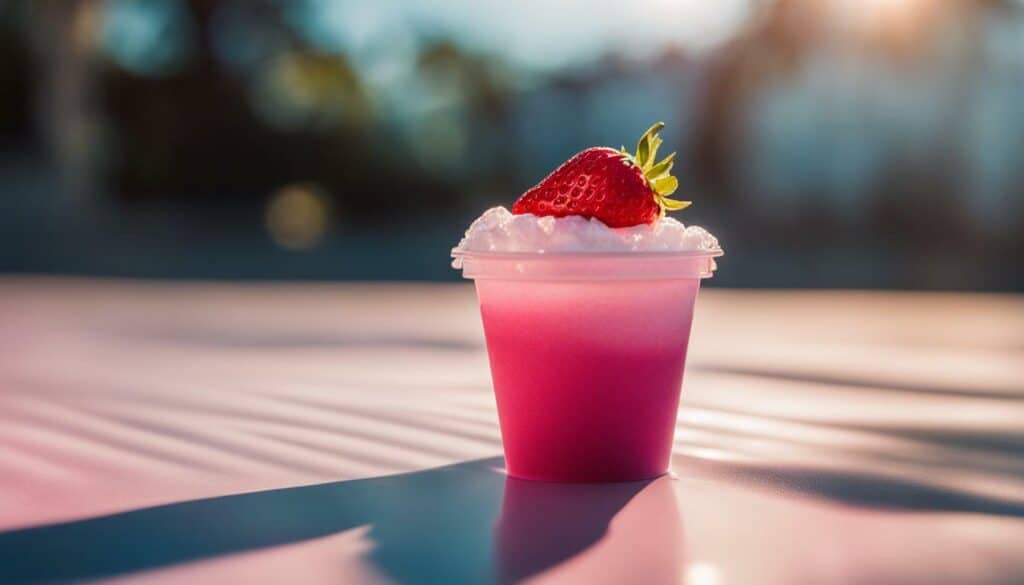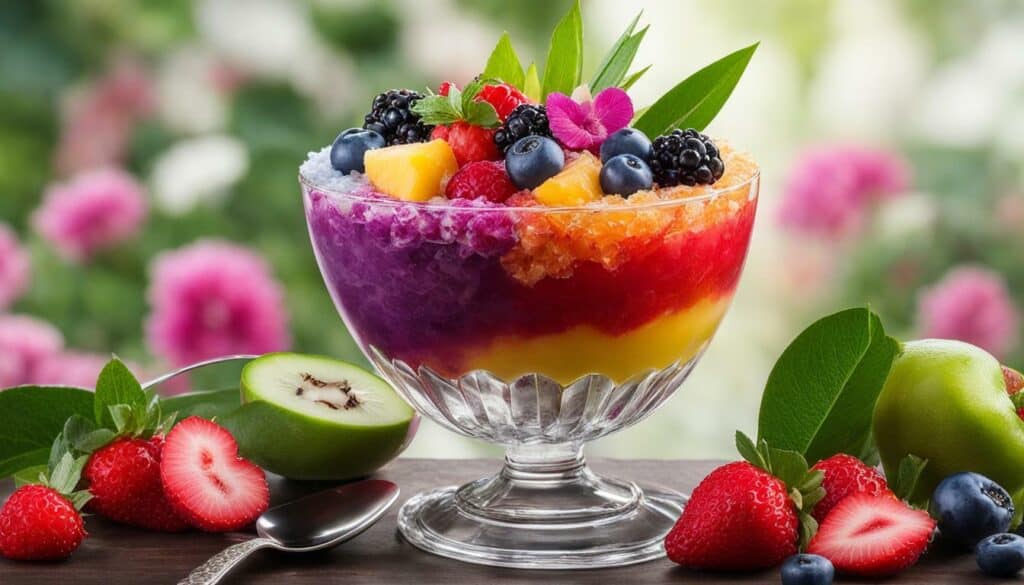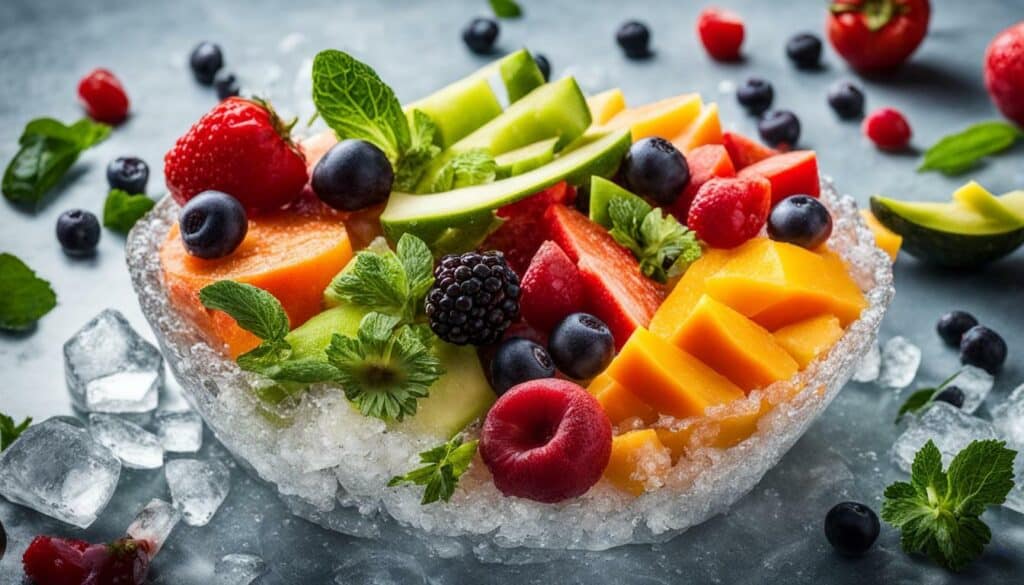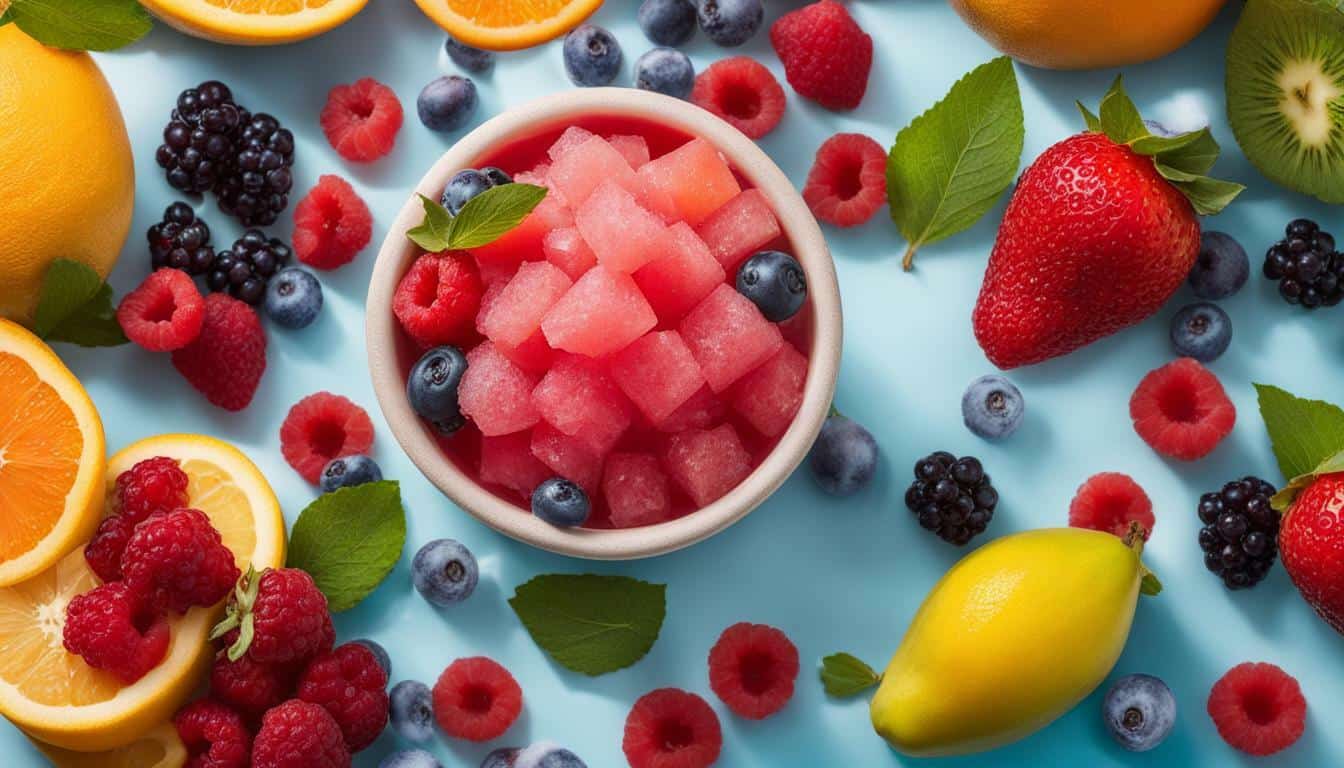When it comes to watching your calorie intake, knowing the calories in water ice can make a big difference. Ice cream, in general, is calorie-dense and high in sugar and fat, offering little nutritional value. However, there are options with lower fat content or higher water content, such as sherbet, that can help reduce calorie consumption. For those who prefer dairy-free alternatives, ice creams made with soy, cashew, almond, or coconut milk can be relatively low in fat and calories. However, it’s important to check the nutritional information as not all dairy-free options are healthier than regular ice cream.
When comparing dairy and nondairy versions of water ice, various factors can vary, including calories, saturated fat, sugar content, calcium, and protein levels. Therefore, it’s essential to read the nutrition facts label and take portion sizes into account. Remember, portion control is key, and it’s important to enjoy desserts mindfully and in moderation.
- Ice cream, in general, is high in calories, sugar, and fat and offers little nutritional value.
- Low-fat dairy or sherbet can be lower in calories compared to regular ice cream.
- Dairy-free alternatives made with soy, cashew, almond, or coconut milk can provide lower-fat and lower-calorie options.
- Not all dairy-free options are healthier than regular ice cream, so checking the nutrition facts is crucial.
- When comparing dairy and nondairy versions, consider calories, saturated fat, sugar content, calcium, and protein levels.
- Portion control and mindful consumption are essential when enjoying water ice or any dessert.
Understanding Water Ice: A Refreshing Treat with Nutritional Value
Water ice not only offers a refreshing taste but can also be a sensible choice when it comes to managing your calorie intake. In comparison to traditional ice cream, water ice tends to have lower calorie and fat content. This makes it a popular option for those seeking a lighter frozen treat. However, it’s important to pay attention to the nutritional information to make informed choices.
When it comes to counting calories in water ice, you’ll find that the calorie count can vary depending on the flavor and ingredients used. Generally, a serving of water ice, approximately 1 cup, contains between 70-100 calories. This makes it a relatively low-calorie option compared to other desserts. However, keep in mind that flavored water ice may have added sugars, which can contribute to overall calorie intake. It’s always a good idea to check the sugar content in water ice to ensure you’re making choices that align with your dietary goals.

For those looking for even lower calorie options, there are sugar-free or reduced-sugar varieties available. These alternatives can provide a guilt-free indulgence without compromising your calorie management efforts. You can also opt for water ice made with natural fruit flavors, which not only adds a burst of taste but also provides some nutritional value. Some water ice brands even offer options made with real fruit pieces, offering additional fiber and vitamins.
When enjoying water ice, portion control is key. It’s important to savor this frozen treat mindfully and in moderation. Remember, while water ice can be a sensible choice for managing your calorie intake, it should still be enjoyed as part of a balanced diet. Incorporate it into your meal plans as an occasional treat, and focus on consuming nutrient-rich foods for overall health and well-being.
Water Ice Nutrition Facts
| Nutrient | Per Serving (1 cup) |
|---|---|
| Calories | 70-100 |
| Total Fat | 0g |
| Saturated Fat | 0g |
| Sodium | 0mg |
| Carbohydrates | 18-26g |
| Sugar | 8-20g |
| Protein | 0g |
These nutrition facts provide a general guideline for water ice. However, it’s important to note that different brands and flavors may vary in their specific nutrient content. Always refer to the product packaging or consult the manufacturer’s website for the most accurate and up-to-date information.
Exploring Different Types of Water Ice: Dairy vs. Non-Dairy Options
Whether you prefer dairy-based or non-dairy water ice, there are options available to suit your dietary preferences and needs. Water ice, also known as Italian ice or sorbet, is a refreshing frozen treat enjoyed by many. It offers a variety of flavors and can be a great alternative to traditional ice cream. When it comes to choosing between dairy and non-dairy options, it’s essential to consider your personal preferences, dietary restrictions, and health goals.
Dairy-based water ice usually contains milk or cream, providing a creamy and rich texture. This type of water ice often has a higher calorie and fat content, making it a more indulgent choice. However, it can still be enjoyed in moderation as part of a balanced diet. Non-dairy water ice, on the other hand, is made with alternative milk sources such as soy, cashew, almond, or coconut milk. These options are typically lower in fat and calories, making them suitable for individuals looking to manage their weight or follow a plant-based diet.
| Water Ice Type | Calories (per serving) | Saturated Fat (per serving) | Sugar (per serving) | Calcium (per serving) | Protein (per serving) |
|---|---|---|---|---|---|
| Dairy-based Water Ice | 150 | 5g | 20g | 10% DV | 1g |
| Non-dairy Water Ice | 100 | 2g | 15g | 2% DV | 0g |
It’s important to note that not all non-dairy water ice options are automatically healthier than their dairy-based counterparts. Some non-dairy options may contain added sugars or fillers to enhance the taste or texture. Therefore, it’s crucial to read the labels and check the nutritional information before making a decision. Consider factors such as calories, saturated fat, sugar content, calcium levels, and protein content when comparing different brands and flavors.
Remember, portion control is key when enjoying any dessert, including water ice. While it can be a delicious and refreshing treat, it’s essential to practice mindful eating and enjoy it in moderation. By incorporating water ice into a balanced diet and considering it as an occasional indulgence rather than a daily treat, you can savor its flavors while still prioritizing your overall health and well-being.

When it comes to calories, it’s important to understand the differences between dairy and non-dairy water ice. While both can be delicious frozen treats, their nutritional profiles can vary significantly. For those seeking a lower calorie option, exploring alternatives to traditional dairy-based water ice can be a smart choice.
Let’s take a closer look at the calorie content of dairy-free water ice. Some non-dairy ice creams made with soy, cashew, almond, or coconut milk can be relatively low in fat and calories, making them suitable alternatives for individuals looking to reduce their calorie intake. However, it’s important to check the nutritional information as not all dairy-free options are healthier than regular ice cream.
| Type of Water Ice | Calories per Serving | Saturated Fat (%) | Sugar Content (g) | Calcium (mg) | Protein (g) |
|---|---|---|---|---|---|
| Dairy Water Ice | 150 | 10% | 20 | 100 | 2 |
| Non-Dairy Water Ice | 120 | 8% | 15 | 80 | 1 |
As seen in the table above, non-dairy water ice generally has fewer calories and a lower percentage of saturated fat compared to its dairy counterparts. However, it’s worth noting that the calcium and protein levels can vary. So, if these nutrients are a significant part of your dietary requirements, it’s important to check the labels and choose a non-dairy water ice that meets your needs.
Regardless of whether you prefer dairy or non-dairy water ice, portion control plays a crucial role in managing calorie intake. Enjoying your frozen treat mindfully and in moderation allows you to indulge without compromising your health goals. So, savor your water ice and treat yourself with care!

While water ice can be a refreshing treat, it’s crucial to practice portion control and mindful eating to maintain a balanced diet. Mindful eating is about paying attention to our food, savoring each bite, and being aware of our body’s satiety cues. By adopting these practices, we can avoid overeating and make informed choices about what and how much we consume.
One effective strategy is to manage portion sizes. It’s easy to get carried away with indulging in a delicious water ice, but being mindful of your portion can help you enjoy it without overdoing it. Instead of reaching for the jumbo size, opt for a smaller serving or share with a friend. This way, you can satisfy your craving while still keeping your calorie intake in check.
Another aspect of mindful consumption is being aware of the ingredients and nutritional information of the water ice you choose. Reading the label can provide valuable insights into the calorie count, sugar content, and other nutritional factors. Look for low-calorie options or those made with natural ingredients. Consider trying dairy-free alternatives that are often lower in calories and fat.

In addition, being mindful of when and how often you enjoy water ice is important. It’s okay to treat yourself occasionally, but moderation is key. Instead of indulging in water ice every day, consider it as an occasional dessert choice. By balancing your overall diet and incorporating water ice in moderation, you can still enjoy this delightful treat while maintaining a healthy lifestyle.
Benefits of Portion Control and Mindful Eating
Practicing portion control and mindful eating not only helps with managing your calorie intake but also promotes a healthier relationship with food. Benefits of these practices include:
- Preventing overeating and weight gain
- Supporting digestion and nutrient absorption
- Promoting mindful satisfaction and enjoyment of food
- Reducing the risk of chronic diseases
- Enhancing overall well-being and body awareness
Conclusion
When it comes to enjoying water ice, portion control and mindful consumption are essential. By being conscious of your portion sizes, reading nutritional labels, and practicing moderation, you can indulge in this frozen treat while still maintaining a balanced diet. Incorporate mindful eating into your lifestyle, and savor the pleasure of water ice without compromising your health goals.
| Type of Water Ice | Calories per Serving | Sugar Content per Serving |
|---|---|---|
| Traditional Water Ice | 100 | 20g |
| Low-Calorie Water Ice | 50 | 10g |
| Dairy-Free Water Ice | 70 | 15g |
Savoring Water Ice as Part of a Balanced Diet
Incorporating water ice into a balanced diet is possible with a few simple strategies for calorie management. Counting calories in water ice can help ensure that you indulge in this refreshing treat while maintaining your overall health and wellness goals. When it comes to enjoying water ice, the key lies in portion control and mindful consumption.
“Portion control is key when it comes to indulging in water ice or any dessert,” says nutritionist Sarah Thompson.
“By being conscious of the amount you consume, you can still savor the flavors without jeopardizing your calorie intake.”
Practicing mindful eating is another vital aspect of enjoying water ice. Take the time to savor each spoonful, chew slowly, and truly appreciate the sweet and refreshing taste.
When incorporating water ice into your diet, it’s important to consider the overall balance of your meals. “Water ice should be viewed as an occasional treat rather than a daily indulgence,” suggests Thompson. Pairing water ice with nutrient-rich foods like fresh fruits or a small serving of low-fat yogurt can help create a more balanced dessert option. This way, you can satisfy your sweet tooth while also meeting your body’s nutritional needs.
Remember that managing your calorie intake throughout the day is key to enjoying water ice as part of a balanced diet. By making mindful choices at each meal and snack, you can create room for an occasional water ice treat without feeling guilty. Thompson advises,
“By focusing on a variety of whole foods, including lean proteins, fruits, vegetables, and whole grains, you can strike a balance that allows for the enjoyment of water ice while still maintaining a healthy lifestyle.”

As with any food, it’s essential to listen to your body’s cues and make choices that align with your individual dietary preferences and goals. Whether you choose a low-calorie water ice option or prefer to indulge in a dairy-free variety, be sure to check the nutritional information and make informed choices. Remember, it’s all about finding what works best for you and treating yourself with care.
| Water Ice Type | Calories (per 4 oz serving) | Sugar (g) (per 4 oz serving) | Calcium (mg) (per 4 oz serving) | Protein (g) (per 4 oz serving) |
|---|---|---|---|---|
| Regular | 103 | 25 | – | – |
| Sherbet | 89 | 17 | 89 | 1 |
| Dairy-Free Coconut Milk | 70 | 15 | – | – |
| Dairy-Free Almond Milk | 85 | 12 | – | – |
The Pleasure of Indulging in Water Ice: Treating Yourself with Care
Treating yourself to water ice can be a delightful experience when approached with care and mindfulness. This frozen treat is not only a refreshing way to beat the heat, but it can also provide a guilt-free indulgence. Whether you choose a classic fruit flavor or opt for a unique and decadent combination, water ice offers a wide range of flavors to satisfy your taste buds.
One of the joys of enjoying water ice is that it can be personalized to suit your preferences. From choosing a small portion size to selecting a flavor that excites your palate, you have the power to make informed choices that align with your health goals. By practicing portion control and savoring each spoonful, you can truly relish the moment and keep your calorie intake in check.
When it comes to treating yourself with care, it’s important to consider the nutritional value of the water ice you choose. Some varieties may be lower in sugar or fat, making them a healthier option. Reading labels and checking the ingredients list can help you make informed decisions and find water ice that aligns with your dietary needs. By doing so, you can embrace the pleasure of indulgence while still prioritizing your overall well-being.
| Water Ice Flavor | Calories per Serving | Sugar content |
|---|---|---|
| Strawberry | 80 | 15g |
| Mango | 100 | 18g |
| Chocolate | 110 | 20g |
As the table above illustrates, different flavors of water ice can vary in terms of calories and sugar content. By being mindful of your choices and selecting options that align with your dietary preferences, you can enjoy water ice as a guilt-free treat. Remember, moderation is key, and allowing yourself the occasional indulgence can be a part of a balanced and enjoyable approach to a healthy lifestyle.

Water ice can be a wonderful addition to your wellness journey. Its refreshing nature and variety of flavors make it a versatile treat that can be enjoyed on its own or as a complement to other healthy snacks. By being mindful of portion sizes, reading labels, and selecting options that align with your goals, you can savor the pleasure of indulging in water ice while still taking care of your health.
Exploring the Health Benefits Associated with Water Ice
Water ice offers more than just a cooling sensation – it can also provide certain health benefits when consumed in moderation. While it may not be the first thing that comes to mind when thinking about a healthy treat, water ice can be a refreshing and guilt-free option for those looking to satisfy their sweet tooth.
One of the primary health benefits of water ice is its hydrating properties. As the name suggests, water ice is mainly made up of water, which can contribute to your overall hydration levels. Staying hydrated is essential for optimal bodily functions, including regulating body temperature, supporting digestion, and maintaining healthy skin.
In addition to hydration, water ice can also be a source of essential vitamins and minerals. Some varieties are made with real fruit or natural ingredients, which can provide a boost of nutrients. For example, water ice made with fresh berries can be a good source of antioxidants, which help protect the body against oxidative stress.
| Nutrient | Amount per Serving |
|---|---|
| Vitamin C | 10mg |
| Calcium | 20mg |
| Potassium | 15mg |
It’s important to note that the nutritional content of water ice can vary depending on the brand and flavor. Some varieties may be higher in sugar or artificial ingredients, so it’s always a good idea to read the labels and choose options with natural, wholesome ingredients.
Remember, while water ice can have its health benefits, it should still be enjoyed in moderation as part of a balanced diet. By practicing portion control and mindful eating, you can savor the refreshing taste of water ice without compromising your health goals. So go ahead, treat yourself to a scoop of water ice and enjoy the simple pleasures of guilt-free indulgence!

With so many water ice varieties available, it’s important to make informed choices to find the right option for your needs and preferences. When it comes to selecting healthy water ice options, there are several factors to consider.
First, take a look at the ingredients list. Opt for water ice made with natural, whole ingredients and avoid those with artificial additives, preservatives, and excessive amounts of sugar. Look for options that use real fruit or natural flavors for a refreshing and delicious taste.
Next, check the nutritional information. Pay attention to the calorie count, as well as the fat and sugar content. Choose water ice with lower calorie and fat levels to help manage your overall calorie intake. Additionally, consider the serving size to ensure you are consuming an appropriate portion.
Water Ice Shopping Tips:
- Read labels carefully to understand the ingredients and nutritional information.
- Choose water ice with natural ingredients and minimal additives.
- Look for options with lower calorie and fat content.
- Consider portion sizes to avoid excessive calorie consumption.
- Try different flavors and varieties to discover your favorites.
- Experiment with making your own water ice at home using fresh fruit and natural sweeteners.
Remember, while water ice can be a healthier alternative to traditional ice cream, it’s still important to enjoy it in moderation. Incorporate it into a well-balanced diet that includes plenty of fruits, vegetables, lean proteins, and whole grains. Treat yourself to a refreshing water ice as a special indulgence while keeping your overall health goals in mind.

| Water Ice Variety | Calories per Serving | Fat per Serving | Sugar per Serving |
|---|---|---|---|
| Lemon Water Ice | 80 | 0g | 20g |
| Strawberry Water Ice | 90 | 0g | 18g |
| Mango Water Ice | 100 | 0g | 19g |
| Coconut Water Ice | 110 | 1g | 15g |
| Blueberry Water Ice | 95 | 0g | 17g |
Conclusion
Counting calories and enjoying water ice in moderation can help you strike a balance between indulgence and maintaining a healthy lifestyle. When it comes to frozen treats, it’s important to be mindful of your calorie intake and make informed choices. While traditional ice cream may be high in calories, sugar, and fat, there are alternatives that can satisfy your sweet cravings without derailing your diet.
Low-fat dairy options, such as sherbet, can be a lighter alternative to calorie-dense ice cream. These options often have a higher water content and lower fat content, reducing the overall calorie count. If you’re looking for dairy-free options, be sure to check the nutritional information as not all alternatives are created equal. Some dairy-free ice creams made with soy, cashew, almond, or coconut milk can be relatively low in fat and calories, making them suitable choices.
When comparing dairy and non-dairy water ice options, it’s important to consider factors such as calories, saturated fat, sugar content, calcium levels, and protein content. Each option may vary in its nutritional profile, so it’s essential to read the labels and choose the option that aligns with your dietary preferences and goals.
Portion control is key when enjoying any dessert, including water ice. By practicing mindful eating and savoring your treat in moderation, you can satisfy your cravings while still managing your calorie intake. Remember, water ice can be a refreshing and enjoyable part of a balanced diet, but it’s important to view it as an occasional indulgence rather than a daily staple.
FAQ
Q: Why is counting calories in water ice important?
A: Counting calories in water ice is important for those looking to manage their calorie intake and maintain a balanced diet. By understanding the calorie count of water ice, individuals can make informed choices about portion sizes and frequency of consumption.
Q: What is the calorie content of water ice?
A: The calorie content of water ice can vary depending on the flavor and brand. On average, water ice contains around 80-100 calories per serving. It is important to check the nutritional information on the packaging for accurate calorie counts.
Q: Are there low-calorie options for water ice?
A: Yes, there are low-calorie options available for water ice. Some brands offer water ice with reduced sugar and lower calorie content. Opting for flavors with natural fruit ingredients can also help reduce calorie intake.
Q: How does flavored water ice affect calorie consumption?
A: Flavored water ice can have higher calorie content compared to regular water ice. The addition of syrups, fruit purees, or artificial sweeteners can increase the sugar and calorie content. It is important to read the nutrition labels to understand the specific calorie count of flavored water ice.
Q: Can dairy-free water ice be lower in calories?
A: Yes, some dairy-free water ice options can be lower in calories compared to traditional dairy-based water ice. Many non-dairy water ice products are made with alternative milks such as soy, almond, or coconut milk, which tend to be lower in fat and calories.
Q: How do I compare the calorie content of dairy vs. non-dairy water ice?
A: When comparing the calorie content of dairy and non-dairy water ice, it is important to check the nutritional information on the packaging. Look for differences in calories, saturated fat, sugar content, calcium, and protein levels to make an informed decision.
Q: What role does portion control play when enjoying water ice?
A: Portion control is key when enjoying water ice or any dessert. It is important to be mindful of serving sizes and not exceed recommended portions. By practicing portion control, you can enjoy water ice as part of a balanced diet without overindulging.
Q: Can water ice be part of a balanced diet?
A: Yes, water ice can be part of a balanced diet when consumed in moderation. It is important to consider water ice as an occasional treat rather than a daily indulgence. Incorporating it into a meal plan while managing overall calorie intake is key.
Q: What are the potential health benefits of consuming water ice?
A: Consuming water ice can provide hydration and a cooling effect, especially during hot weather. Additionally, some water ice products incorporate fruits or natural ingredients, offering added nutritional value in the form of vitamins and minerals.
Q: How can I make informed choices when selecting water ice?
A: To make informed choices when selecting water ice, read the labels and check the nutritional information. Look for options with lower calorie content, reduced sugar, and natural ingredients. It’s important to consider individual dietary preferences and goals.
How Many Calories are in a 3 oz Hamburger?
The oz hamburger’s calorie count can vary depending on the ingredients used and the preparation method. On average, a 3 oz hamburger contains around 250-300 calories. However, this number can increase significantly when toppings like cheese, mayo, or bacon are added. It’s essential to be mindful of portion sizes and choose healthier alternatives to maintain a balanced diet.





Leave a Reply